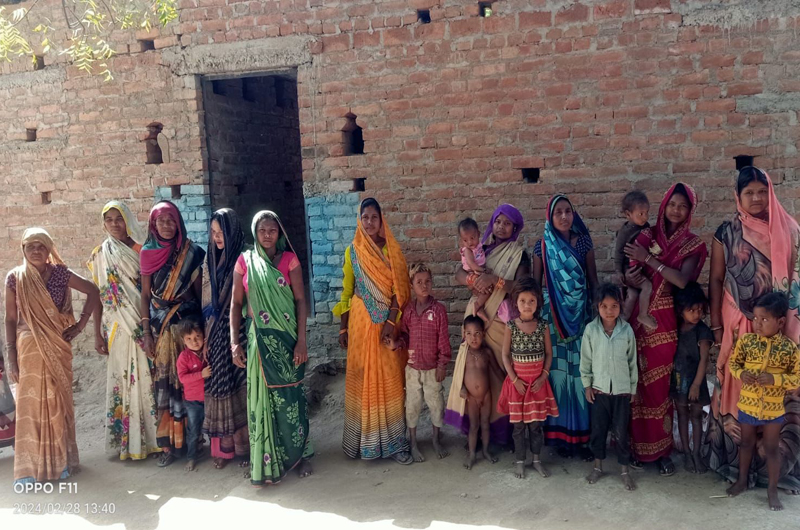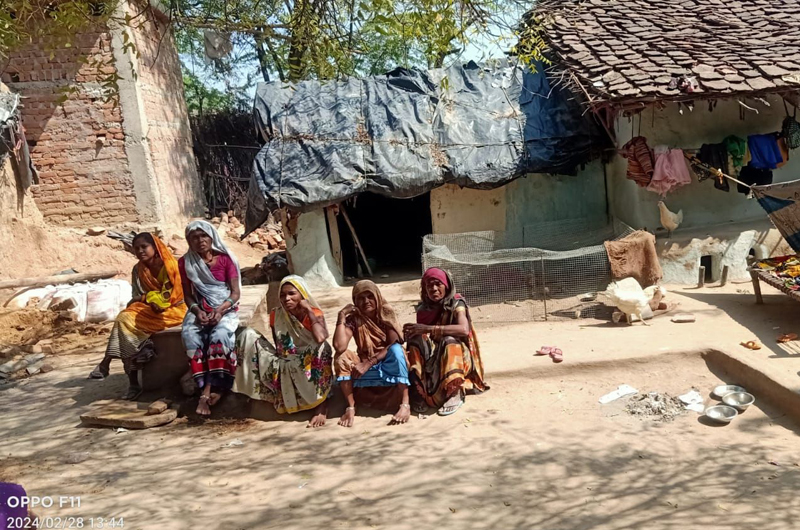Bharat Dogra visits a remote settlement in Uttar Pradesh where the tribal inhabitants battle a feudal system even as the benefits of government schemes trickle in
As we moved away from the Bundelkhand Expressway into the by-lanes, the hills of Chitrakoot became more and more deserted, till we reached what appeared to be a dead-end. Welcome to Dafai hamlet, located in Karwi Block of Uttar Pradesh’s Chitrakoot District, which over 80 households of the tribal Kol community have been calling home for a long time. This settlement was formed several decades ago, when some dominant individuals involved in large-scale, highly-lucrative stone quarries wanted to have many workers at their beck and call for the hazardous stone-crushing work. They encouraged the Kol families living in vulnerable conditions elsewhere to settle on some vacant land, and that became Dafai.
When I first visited this hamlet about five years back, I learnt that these families had no farmland, and even the land on which their small mud houses stood was still claimed by their feudal employers as their own. These individuals tried their best to keep the tribal families out of the purview of government benefits which could have brought them some relief.
I learnt that most people living here did not have ration cards or job cards, and nearly 90 per cent of the children were not in school at the time. The hamlet did not have electricity connections, and the only source of water supply was a hand pump. If the pump did not work, the villagers had to go a long way to fetch water. There were no toilets in Dafai, and women in particular were constrained to go to an isolated place to relieve themselves in unsafe conditions.
In addition, working conditions in stone crushing units are very harmful to health and we also had to rush relief to the people to combat the cold wave. Back home in Delhi, I got information of other, serious trouble in the hamlet. Taking advantage of the increased vulnerability of women workers in crushing units during COVID times, some employers started subjecting them to sexual exploitation. Vidyadham Samiti, the leading voluntary organisation working in this area, tried to check this development, and news of violence against women appeared in some media outlets, both local and national.
Unfortunately, instead of acting to stop this, the police initially responded by victimising and humiliating the chief functionary of Vidyadham Samiti, Raja Bhaiya, widely known for his commitment to the rights of the most vulnerable communities. Pressure was also exerted on the people of Dafai, the women in particular, to falsely implicate him in some case, but the people refused to say anything untrue against the man who had sincerely tried to help them. (Vidyadham Samiti had also been widely involved in distributing relief during COVID times).
An appeal to the National Human Rights Commission resulted in the police official involved in the harassment of Raja Bhaiya being fined Rs 50,000, and this amount being paid as compensation to Raja Bhaiya. This turn of events allowed Vidyadham Samiti to again devote itself to getting justice for the people of Dafai. Meanwhile, the distant hamlet had come so much into focus that the administration selected it as the beneficiary of several development schemes. Job cards and ration cards were made. Tap connections were provided under the ongoing scheme (although water is yet to reach these taps).
On the other hand, most of the villagers have lost their jobs as crushers due to mechanisation or other factors. They have now become migrant workers at brick-kilns. The women here have been asking for work close to their village. However, NREGA work is only rarely available and, even when it is, wage payouts are delayed. Despite the recent increase of developmental work, no toilets have so far been constructed. (The toilet construction scheme specifies a grant of Rs 12,000, but this has not reached the village yet, and there are calls for an increase in the amount keeping in view realistic costs.) Electricity connections been not been given to the village either.

Nonetheless, in a rare decision, almost all the households here were selected under the PM Awas Scheme for new house construction. Nearly 70 per cent of these houses have been constructed or are nearing completion. This has infused the villagers with a new confidence – the fact that the government has helped with the constructions has made their housing situation more secure. One family has constructed the new house in such a way that both the new and the old edifices can be used. “In the winter and the rainy season, I like to live in the new pucca (permanent and solid) house, but during most of the year, when it is hot, I still like to live in the kutcha (raw) portion,” the lady of the house told me. This is a reminder that the old houses can also be useful, particularly in these times of climate change.
However, around Rs 2 lakh is needed per housing unit, and the amount sanctioned is only Rs 1.20 lakh, to be paid out in three instalments, after certain work has been completed. As the amount given was not adequate, people had to borrow money from private moneylenders at high interest rates, which they have been repaying for about two years. Also, the beneficiaries have been providing unskilled labour, and they were supposed to be paid for this. They were told the likely sum was Rs 18,000 or so, but they have not received this yet.
And the feudal-minded employers continue to threaten them with eviction. So, Dafai’s journey of despair continues, and the hamlet needs support to strengthen the hope of its people.
(The writer is a senior freelance journalist and author who has been associated with several social movements and initiatives.
He lives in New Delhi.)



 from Webdoux
from Webdoux